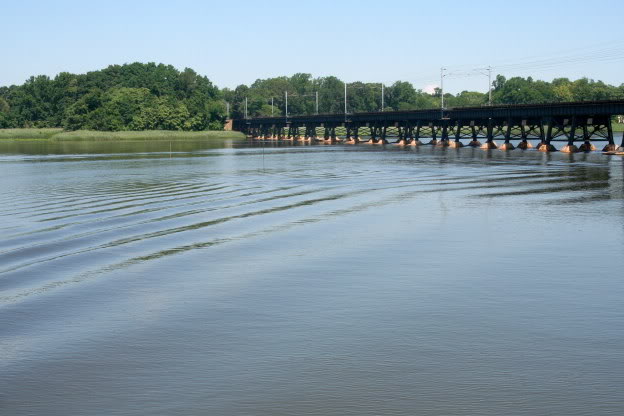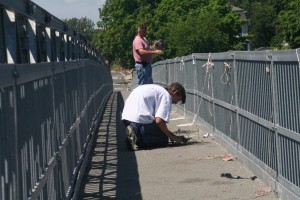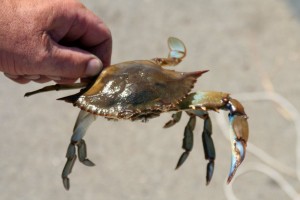 Both my husband and I took the day off from work to go crabbing – I was looking for an excuse to play *hooky* and he offered. It was a beautiful day today – hot, but without the humidity that has been so oppressive all week. Our usual spot to crab is from a little bridge over the Swimming River in Red Bank – further down the river past the railroad bridge you see in the pic this river becomes the Navesink, five miles or so downriver is Sandy Hook Bay and the Atlantic Ocean.
Both my husband and I took the day off from work to go crabbing – I was looking for an excuse to play *hooky* and he offered. It was a beautiful day today – hot, but without the humidity that has been so oppressive all week. Our usual spot to crab is from a little bridge over the Swimming River in Red Bank – further down the river past the railroad bridge you see in the pic this river becomes the Navesink, five miles or so downriver is Sandy Hook Bay and the Atlantic Ocean.
Crabbing requires little investment or pre paration, but is a very repetitive pastime. We set up twenty or so traps across the span of the bridge, excepting the middle part of the bridge where our trap lines would interfere with the boat channel below. I watched and took pictures at this point, rather than handle the bait (fish or raw chicken) – left that yuckiness to my DH and his brother. The rest is easy – check the trap every so often, lifting it from the bottom hand-over-hand, and seeing what you’ve caught. There is a 4 1/2-inch minimum size, measured point to point across the back and we throw back any females we catch.
paration, but is a very repetitive pastime. We set up twenty or so traps across the span of the bridge, excepting the middle part of the bridge where our trap lines would interfere with the boat channel below. I watched and took pictures at this point, rather than handle the bait (fish or raw chicken) – left that yuckiness to my DH and his brother. The rest is easy – check the trap every so often, lifting it from the bottom hand-over-hand, and seeing what you’ve caught. There is a 4 1/2-inch minimum size, measured point to point across the back and we throw back any females we catch.
The majority of what we caught today were too small to keep, and these little ones usually fall out of the trap as you pull it out of the water. The keepers present somewhat of a challenge to me, as they often just won’t be flipped into the bushel basket like a cooperative crab ought to. Instead, they find something to hold onto and won’t let go. Shaking the whole trap works, but then you have a crab running around your Teva-sandaled feet. My husband just catches them under his shoe, but he wears steel-toed boots. Crabs can pinch painfully, even drawing blood, and the claws should definitely be avoided!
Here my husband is demonstrating to me the proper technique for holding a crab by the base of one of its swimming appen dages called “swimmerets” or “paddles” located at the rear of the shell. My husband tells me the big, snapping male blue claws aren’t able to reach around and nip a finger this way. Once you have a hold of them and are sure the size is big enough and that it’s a male you can then flip it into the basket. Adding a crab into the bushel causes the others to scurry around threateningly – that snapping, lunging mass is no place for your hand! You have to keep the basket in the shade and the crabs moist with a wet towel, but they’ll live with proper ventilation for a few hours until you get them home to the pot.
dages called “swimmerets” or “paddles” located at the rear of the shell. My husband tells me the big, snapping male blue claws aren’t able to reach around and nip a finger this way. Once you have a hold of them and are sure the size is big enough and that it’s a male you can then flip it into the basket. Adding a crab into the bushel causes the others to scurry around threateningly – that snapping, lunging mass is no place for your hand! You have to keep the basket in the shade and the crabs moist with a wet towel, but they’ll live with proper ventilation for a few hours until you get them home to the pot.
We ended the day with 50 or so keepers for my husband’s mom and terrific sunburns. My shoulders and the backs of my knees are red like a lobster – sleeping should be interesting for the next few nights.
I am green with envy. I feasted on crab at The Tap Room in Chesepeake City last month when on the Delmarva Peninsula for my 20th HS Reunion, but its has been an age since I went crabbing. Baystaters ignore out perfectly decent blue crabs and go straight for the lobstah and steamers. The kids and I plan a clam bake in a couple of weeks, though, and I can get some blue crabs I’ll add them to the pile.
Sounds like you had a great “hookey” day. Sorry about the sunburn – slather on that soothing aloe vera. I hope your husband’s mom is generous and shares the bounty with her hardworking DIL.
yep, Pam is right, aloe vera is the ticket! What I hate is the bra strap on a sunburn – big ouch!
thanks for the instruction on crabbing-important not to get pinched! Your hubby has a great technique, there.
I love crabbing. We haven’t been since July last year when we spent a weekend at Sandbridge.
Sounds like you had a fun day – sorry about the sunburn. Yee-ouch.
I’ve had serious sunburn in my youth, and my gene pool is from far northern latitudes so I land between crimson and scarlet. Plantain to the rescue! If you can still bend your knees, find bunches of it, wash leaves well and juice in a blender. Apply the cool goop to burned skin. If you recognize agrimony it can be used also, separately or the two together. If you’re already unbendable, brew the strongest black tea you can and apply it cold from a spray bottle. Tea’s tannins soothe and heal burned skin. BFE Rescue Remedy will help any of the above to work more immediately and effectively. BurnyBooBoo Juice 🙂
I’m not much of a shellfish fan (since age 8 when my dad showed us how to cook lobster in Maine) but it sounds like fun to go crabbing!
Poor sunburned Laura…what are you thinking, carrying that pale skin of yours out into the sun? Sending you cool thoughts and aloe dreams!
🙂
Does your MIL get them all, or do you eat them, too? It’s a good thing when people get to see where their food really comes from. This makes me think of Michael Pollan’s new book: “The Omnivores Dilemma.” I haven’t read it yet, but I think one of the things he talks about is how we have become so removed from the sources of our food that we don’t value and appreciate the natural systems that sustain us.
Tim: A clambake sounds great – ever done that on the beach?
Aloe vera is cooling me off.
😉
Sharon: that cold black tea in a spray bottle sounds like a great idea – I’ll need someone to spray me down, though cause the burn is all on my back parts.
Just realized looking at that crab pic that it has only one claw – wonder how he lost the other?
Susan: I’m not much interested in the crab myself, but like the crabbing! Fun to be out and get all fishy-smelling. 😉 I’ve tried to convince my DH to go to a different spot that has more birds and less car traffic, but it’s a no go.
mojoman: I’ve not read that book, but would like to soon. I heard an interview with the author on NPR a while back and the book sounds interesting.
I do think that people are clueless about where their food comes from and many like it that way! Think of the cattle industry or chicken *processing* plants, etc. – much easier to pick up your cellophane wrapped meat in the market than think about where it comes from. No guilty conscience that way.
Does he talk about “eating locally” in that book, do you know?